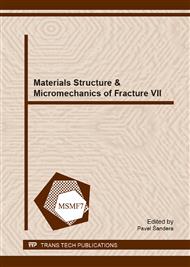p.594
p.598
p.602
p.606
p.610
p.614
p.618
p.622
p.627
Determining Elastic-Plastic Properties of Al6061-T6 from Micro-Indentation Technique
Abstract:
Different approaches have been proposed in order to determine the material behavior of ductile materials. Since, the mechanical properties of a mechanical component are modified during manufacturing process due to plastic deformation, heat treatment and etc, a non-destructive indentation experimental procedure addressed to predict the elastic-plastic properties of material after manufacturing process is of interest. This is especially true for small size components where it is complex to extract specimens to test on standard test system. Based on dimensionless analysis and the concept of a representative strain, different approaches have been proposed to determine the material properties of power law materials by using indentation process. In this work, the Johnson-Cook (JC) constitutive model of the aluminum alloy Al6061-T6 is characterized by means of a well-defined optimization procedure based on micro-indentation testing and high fidelity finite element models and an optimization procedure but without the concept of dimensionless analysis and a representative strain. This methodology allows determining a set of JC constants for Al6061-T6. The obtained results have good agreement with parameters calibrated by means of universal standard tests and reverse engineering approach.
Info:
Periodical:
Pages:
610-613
Citation:
Online since:
November 2013
Authors:
Price:
Сopyright:
© 2014 Trans Tech Publications Ltd. All Rights Reserved
Share:
Citation:


